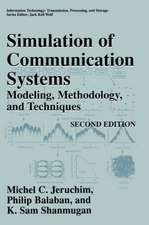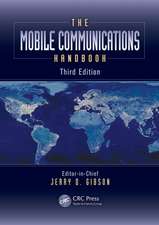Lateral Electromagnetic Waves: Theory and Applications to Communications, Geophysical Exploration, and Remote Sensing
Autor Ronold W. P. King, Margaret Owens, Tai T. Wuen Limba Engleză Paperback – 14 oct 2011
Preț: 1024.57 lei
Preț vechi: 1249.48 lei
-18% Nou
Puncte Express: 1537
Preț estimativ în valută:
196.08€ • 203.95$ • 161.87£
196.08€ • 203.95$ • 161.87£
Carte tipărită la comandă
Livrare economică 14-28 aprilie
Preluare comenzi: 021 569.72.76
Specificații
ISBN-13: 9781461391760
ISBN-10: 1461391768
Pagini: 776
Ilustrații: XXVIII, 746 p.
Dimensiuni: 155 x 235 x 41 mm
Greutate: 1.15 kg
Ediția:Softcover reprint of the original 1st ed. 1992
Editura: Springer
Colecția Springer
Locul publicării:New York, NY, United States
ISBN-10: 1461391768
Pagini: 776
Ilustrații: XXVIII, 746 p.
Dimensiuni: 155 x 235 x 41 mm
Greutate: 1.15 kg
Ediția:Softcover reprint of the original 1st ed. 1992
Editura: Springer
Colecția Springer
Locul publicării:New York, NY, United States
Public țintă
ResearchDescriere
The propagation of waves along and across the boundary between two media with different characteristic velocities is much more complicated when the source is on or near the boundary than when it is far away and the incident waves are plane. Examples of waves generated by localized sources near a boundary are the electromagnetic waves from the currents in a dipole on the surface of the earth and the seismic waves from a slip event in a fault in the earth's crust like the San Andreas fault in California. Both involve a type of surface wave that is called a lateral wave in electro magnetics and a head wave in seismology. Since the two are analogous and the latter is more easily visualized, it is conveniently used here to introduce and describe this important type of surface wave using the data of Y. Ben Zion and P. Malin ("San Andreas Fault Zone Head Waves Near Parkfield, CA," Science 251, 1592-1594, 29 March 1991).
Cuprins
1 Historical and Technical Overview of Electromagnetic Surface Waves; Introduction to Lateral Waves.- 1.1 Electromagnetic Waves.- 1.2 Electromagnetic Waves Along Surfaces.- 1.3 Surface Waves in the Field of a Vertical Electric Dipole over the Earth; The Formula of Norton.- 1.4 General Integrals and Approximate Formulas.- 1.5 Numerical Methods with High-Speed Computers.- 1.6 Lateral Waves.- 1.7 Lateral Waves and the Geoelectromagnetic Investigation of the Earth’s Crust and Upper Mantle.- 2 Electromagnetic Preliminaries.- 2.1 Maxwell’s Equations; Parameters.- 2.2 The Vector and Scalar Potentials; The Electromagnetic Field of a Unit Electric Dipole.- 2.3 The Electromagnetic Field of a Unit Magnetic Dipole.- 2.4 The Reflection and Transmission of Plane Waves at the Plane Boundary Between Electrically Different Media.- 2.5 The Reflection and Transmission of Plane Waves at the Boundary Between Two Lossless Half-Spaces (Case A).- 2.6 The Reflection and Transmission of Plane Waves at the Boundary of a Dissipative Half-Space (Case B).- 2.7 The Reflection and Transmission of Plane Waves Incident from a Lossy Half-Space (Cases C and D).- 3 The Electromagnetic Field of a Unit Vertical Electric Dipole in the Presence of a Plane Boundary.- 3.1 Maxwell’s Equations and Their Transforms.- 3.2 Solution of the Transformed Equations.- 3.3 General Integrals for the Field When the Dipole Is in Region 1.- 3.4 Integrated Formulas for the Electromagnetic Field of a Vertical Electric Dipole at the Depth d in Region 1.- 3.5 The Polarization of the Electromagnetic Field of a Vertical Electric Dipole on the Boundary in Region 1; Wave Tilt.- 3.6 The Complete Electromagnetic Field in Region 1 of the Vertical Electric Dipole in Region 1.- 3.7 The Field in Region 2 for the Vertical Electric Dipole in Region 1.- 3.8 Alternative Derivation of the Field in Region 2 for the Vertical Electric Dipole in Region 1.- 3.9 Generalization of the Field in Region 2.- 4 Applications of the Theory of the Vertical Dipole Near The Boundary Between Two Half-Spaces.- 4.1 Limitations of the Theory.- 4.2 Radio Communication over the Surface of the Earth; Electromagnetic Field in Air Due to a Vertical Electric Dipole at Height d in Air.- 4.3 Division of Radiated Power Between Air and Earth Half-Spaces.- 4.4 Communication with Submarines—Unit Vertical Dipole.- 4.5 Communication with Submarines—A Practical Antenna.- 4.6 The Measurement of the Conductivity of the Oceanic Crust with a Vertical Electric Dipole as the Source—Theory.- 4.7 The Measurement of the Conductivity of the Oceanic Crust Using a Vertical Dipole—Comparison of Theory with Measurement.- 4.8 A Note on the Effective Length of the Antenna.- 5 The Electromagnetic Field of a Horizontal Electric Dipole in the Presence of a Plane Boundary.- 5.1 Introduction.- 5.2 Maxwell’s Equations and Their Transforms.- 5.3 Solution of the Differential Equations for ?x and Bx.- 5.4 The Components of the Electromagnetic Field of the Horizontal Dipole as General Integrals.- 5.5 Integrated Formulas for the Electromagnetic Field in Regions 1 and 2 of the Horizontal Electric Dipole at the Depth d in Region 1.- 5.6 Evaluation of the Integrals for the Electromagnetic Field in Region 1 of the Horizontal Electric Dipole at the Depth d in Region 1.- 5.7 Evaluation of the Integrals of the Field in Region 2 of the Horizontal Electric Dipole at the Depth d in Region 1.- 5.8 Alternative Derivation of the Field in Region 2 of the Horizontal Electric Dipole at the Depth d in Region 1.- 5.9 The Locus of the Poynting Vector and the Depth of Penetration of the Lateral Wave in Region 2.- 5.10 Generalization of the Field in Region 2.- 6 Interference Patterns; Comparison of Approximate Formulas with General Integrals and Measurements.- 6.1 Introduction.- 6.2 Radial Electric Field and Interference Patterns.- 6.3 The Complete Electric and Magnetic Fields.- 6.4 Comparison of Theory with Measurements.- 7 Applications of the Theory of the Horizontal Dipole Near the Boundary Between Air and Earth or Sea.- 7.1 Comparison with the Vertical Dipole.- 7.2 Lateral-Wave Propagation over the Surface of the Earth and into the Ocean—Unit Horizontal Dipoles.- 7.3 The Wave Antenna for Communication over the Earth.- 7.4 Communicating with Submarines with Horizontal Antennas.- 7.5 Lateral Waves from a Horizontal Antenna for Remote Sensing in the Earth or Water.- 7.6 Lateral Electromagnetic Waves from a Horizontal Antenna for Remote Sensing in the Ocean.- 7.7 On the Detection of Submerged Submarines with Lateral Electromagnetic Waves.- 7.8 Detection of Magnetic Field Instead of Electric Field.- 7.9 Determination of the Permittivity and Conductivity of the Earth from Measurement of the Admittance of a Horizontal Antenna.- 7.10 Field of a Horizontal Electric Dipole in the Air over Earth or Sea; Application to FM Communication and Television.- 8 The Measurement of the Conductivity of the Oceanic Lithosphère with a Horizontal Antenna as the Source.- 8.1 The Homogeneous Isotropic Half-Space Model of the Oceanic Lithosphere—Theory.- 8.2 The Measurement of ?2.- 8.3 The Measurement of ?2.- 8.4 Comparison with Measurements.- 8.5 Reflections from an Ideal Reflecting Layer.- 8.6 Interpretation of Measured Data.- 9 Lateral Waves in a One-Dimensionally Anisotropie Half-Space.- 9.1 Introduction.- 9.2 Transform of Maxwell’s Equations; Equations for ?x and Bx.- 9.3 Solutions of the Differential Equations for ?x and Bx.- 9.4 Approximate Integrated Formulas for the Complete Field in Region 1.- 9.5 Comparison with Measurements.- 9.6 Evaluation of the Integrals for the Field in Region 1 over a Homogeneous Anisotropic Region 2.- 9.7 Evaluation of H?1(?, 0), Hø1( ?, 0), and Hz1 (?, 0).- 9.8 Three-Dimensionally Anisotropic Region 2.- 10 The Propagation of Lateral Electromagnetic Waves in Air over Vertical Discontinuities.- 10.1 Review of Formulas for the Field in Homogeneous Isotropic Half-Spaces.- 10.2 Formulation of the Problem When the Properties of Region 1 Are Discontinuous.- 10.3 The Scattered Field in Regions 1 and 3.- 10.4 Numerical Evaluation of the Scattered Field; The Total Field.- 10.5 Propagation in the Presence of a Metal Wall in the Air; Induced Current and Scattered Field.- 10.6 Experiments on the Reflection of Lateral Electromagnetic Waves.- 11 The Horizontally Layered Half-Space.- 11.1 Description and Notation; Reflection Coefficients.- 11.2 The n-Layered Half-Space.- 11.3 The Surface Impedance and Reflection Coefficient for an n-Layered Region: Electric Type.- 11.4 The Surface Admittance and Reflection Coefficient for an n-Layered Region: Magnetic Type.- 11.5 The Electromagnetic Field in Region 1 over an n-Layered Half-Space.- 11.6 The Three-Layered Region; General Formulas.- 12 The Three-Layer Problem for Sediment on the Oceanic Crust.- 12.1 Introduction.- 12.2 Integrals for the Components of the Field of a Horizontal Electric Dipole.- 12.3 Approximate Formulas for the Quantity (?1/2)(Q3 –1).- 12.4 Approximate Formulas for the Quantity (?1/2?1)(P3 + 1).- 12.5 Evaluation of F?1 (?, z + d) and Fø1 (?, z + d).- 12.6 Evaluation of Fz1(?, z + d); Formulas for the Electric Field.- 12.7 Evaluation of G?1 (?, z + d) and Gø1 (?, z + d).- 12.8 Evaluation of Gz1(?, z + d); Formulas for the Magnetic Field.- 12.9 The Lateral-Wave Field; Comparison of Theoretical and Numerical Results.- 12.10 Application of the Three-Layer Formula to the Sea Floor.- 12.11 Integrals for the Components of the Field of a Vertical Electric Dipole.- 13 Exact Formulas for the Lateral Electromagnetic Pulses Generated by Vertical Dipoles.- 13.1 Introduction.- 13.2 The Time-Independent Field of a Unit Vertical Electric Dipole on the Boundary Between Electrically Different Half-Spaces.- 13.3 The Time-Dependent Component E2z(?,t) with a ?-Function Excitation.- 13.4 Evaluation of the Integrals for E2z(?,t).- 13.5 Evaluation of E2z(?,t).- 13.6 The Time-Dependent Component B2ø(?,t) with a ?-Function Excitation.- 13.7 The Time-Dependent Component E2?(?,t) with a ?-Function Excitation.- 13.8 The Hertz Potential with ?-Function Excitation.- 14 Approximate Formulas for Lateral Electromagnetic Pulses Generated by Vertical and Horizontal Electric Dipoles.- 14.1 Integrals for the Approximate Time-Dependent Field of a Vertical Dipole; ?-Function Excitation.- 14.2 Evaluation of Integrals.- 14.3 The Approximate Time-Dependent Electromagnetic Field of the Vertical Dipole with ?-Function Excitation; Comparison with Exact Field.- 14.4 Generalization to the Field When the Source and Point of Observation Are in the Dielectric Region 1.- 14.5 Approximate Time-Domain Formulas for the Field of a Horizontal Electric Dipole; ?-Function Excitation.- 14.6 The Approximate Transient Field of a Vertical Dipole Excited by a Gaussian Pulse.- 14.7 The Exact Transient Field of a Vertical Dipole Excited by a Gaussian Pulse.- 14.8 The Approximate Transient Field of a Horizontal Dipole Excited by a Gaussian Pulse.- 15 The Propagation of Signals Along a Three-Layered Region: Open Microstrip.- 15.1 Introduction.- 15.2 The Horizontal Electric Dipole on or above the Air-Dielectric Boundary.- 15.3 Evaluation of the Integrals for the Field of the Horizontal Dipole over Microstrip.- 15.4 Integrated Formulas for the Components of the Electromagnetic Field.- 15.5 Comparison of the Electromagnetic Field of the Horizontal Dipole in Three Related Environments.- 15.6 The Propagation of Pulses on Microstrip.- 15.7 The Propagation of a Gaussian Pulse Along the Boundary Between Air and a Dielectric.- 15.8 The Transient Electric Field Generated in Open Microstrip by a Horizontal Dipole Excited by a Gaussian Pulse.- 15.9 Microstrip Transmission Lines.- 15.10 Gaussian Pulse Propagation on an Open Microstrip Transmission Line.- 15.11 Radiation from a Unit Dipole on a Dielectric Substrate.- 15.12 Microstrip Antennas.- 15.13 Generalization of the Theory; Application to Surface-Wave Propagation over the Arctic Ice.- 16 Antennas in Material Media Near Boundaries: The Bare Metal Dipole.- 16.1 Introduction.- 16.2 The Bare Cylindrical Antenna in a Dissipative Medium.- 16.3 The Effective Length and Figure of Merit of the Bare Antenna.- 16.4 The Bare Cylindrical Antenna in a Dissipative Medium Near a Boundary.- 16.5 Summary and Conclusions.- 17 Antennas in Material Media Near Boundaries: The Terminated Insulated Antenna.- 17.1 Circuit Properties of Insulated Antennas.- 17.2 The Effective Length of the Insulated Antenna.- 17.3 Antennas for Special Purposes: An Underground Antenna.- 17.4 Antennas for Special Purposes: An Antenna for the Sea Floor at f = 1 kHz.- 17.5 Antennas for Special Purposes: An Antenna for the Sea Floor at Very Low Frequencies.- 17.6 Conclusion and Summary.- 18 The Wave Antenna.- 18.1 Introduction.- 18.2 Description of the Wave Antenna and Its Surroundings.- 18.3 The Electric Field Due to Dipoles with Unit Electric Moment.- 18.4 The Electric Field of the Vertical Elements of the Beverage Antenna.- 18.5 The Electric Field of the Horizontal Elements of the Beverage and Horizontal-Wire Antennas.- 18.6 The Electric Field of the Beverage Antenna.- 18.7 The Electric Field of the Horizontal-Wire Antenna.- 18.8 Summary: The Beverage and Horizontal-Wire Antennas for Transmission.- 18.9 The Beverage and Horizontal-Wire Antennas for Reception—The Current in the Main Horizontal Wire.- 18.10 The Beverage and Horizontal-Wire Antennas for Reception—The Current Due to the Terminations, in the Load, and in the Entire Antenna.- 18.11 Generalization of the Field of the Wave Antenna for Application to Over-the-Horizon Radar Using Ionospheric Reflections.- Appendix A: Tabulation of Integrals.- Appendix B: Evaluation of Integrals with Radicals in the Integrand.- Appendix C: Evaluation of Integrals of Bessel Functions.- Appendix D: Evaluation of Integrals with Products and Quotients of Radicals.- Appendix G: Evaluation of Integrals for the Power in the Air and in the Earth Radiated by a Vertical Dipole in the Air above a Dielectric Earth.











